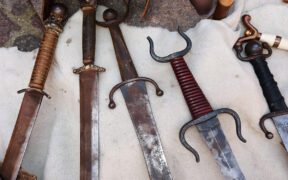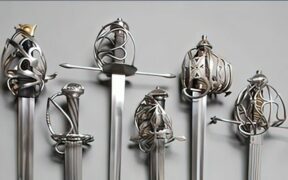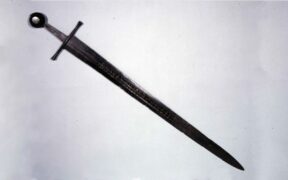Our content features commercial links to our products, committed to transparent, unbiased, and informed editorial recommendations. Learn More
English Swords Through the Ages: A Look at the Iconic Blades of British History
NO AI USED This Article has been written and edited by our team with no help of the AI
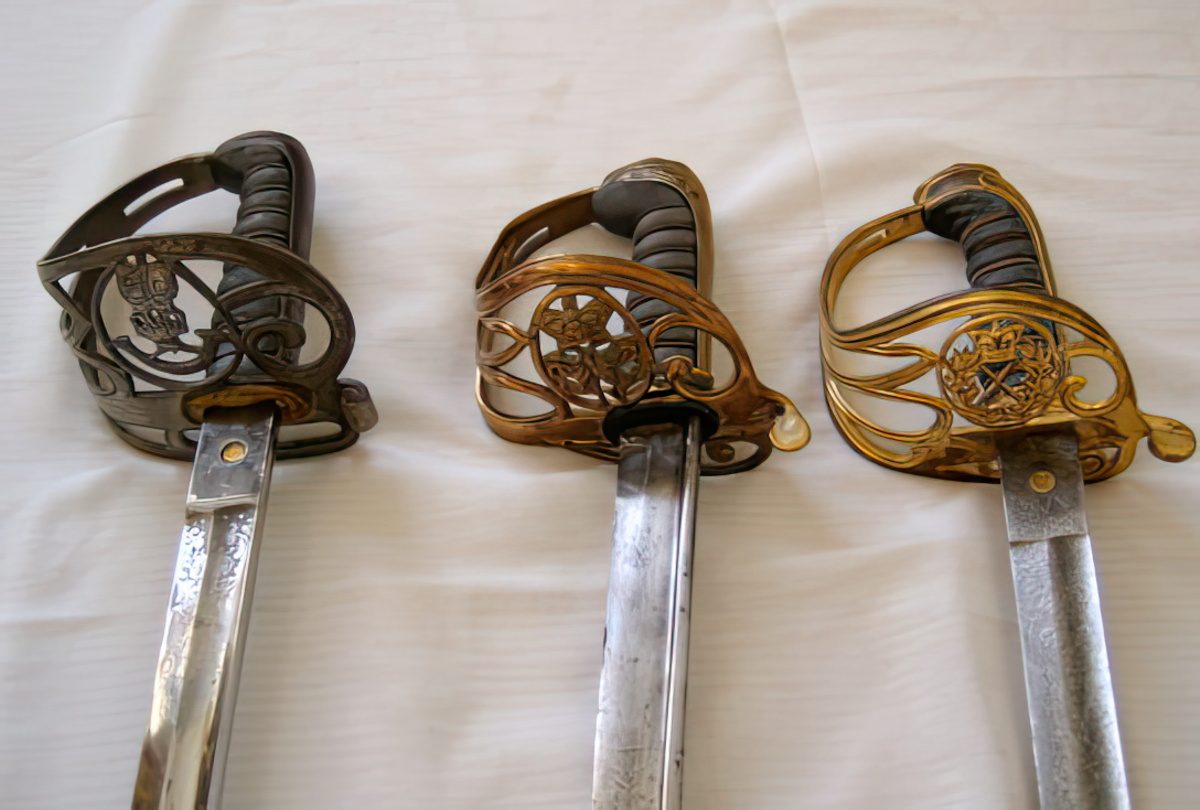
From the 5th to 19th centuries AD, English soldiers used swords to slash, cut, and stab their enemies on the battlefield. As swords became cheaper to produce, civilians also carried these weapons to use in duels and skirmishes. Throughout this period, swords in England evolved, changing and adapting to become more effective against mail and plate armor. Let’s take a look at this evolution and the different types of swords in English History.
Types of English Swords
As European warfare changed from the Middle Ages to the Renaissance to the Enlightenment, what remained the same was the presence of the sword in some form or fashion. From quick-cutting short swords to armor-smashing great swords, each era featured its own unique blades. Here are some of the most iconic weapons in English history:
1. Anglo-Saxon Sword (5th-10th Century AD)
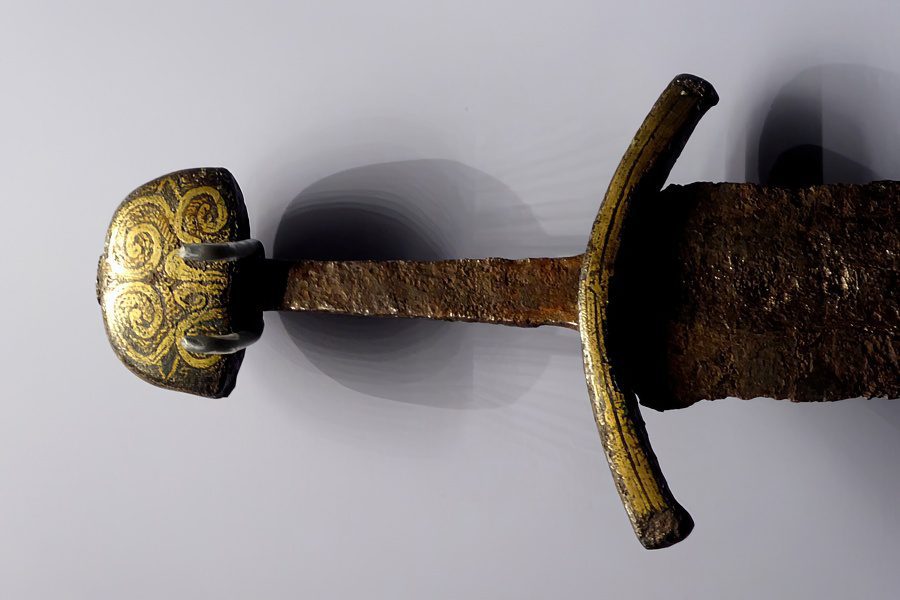
The history of English swords begins with the Anglo-Saxon broadsword in the early medieval period. Featuring a double-edged straight blade with a simple hilt consisting of a pommel and a straight crossguard, the Anglo-Saxon sword is a descendant of the spatha, a sword used by the Roman cavalry that was adapted by Germanic tribes.
The blade length averaged around 30-37 inches, and the tip of the blade was more rounded, indicating that these swords were primarily used for cutting and slashing as opposed to thrusting. To forge these swords, smiths employed a process called pattern welding, a technique that twisted carbon steel and iron bands together to form a distinctive pattern.
Because this forging process was expensive and time-consuming, swords and decorated scabbards were typically worn by the more elite members of society, serving as a marker of status among Anglo-Saxon communities. The weapons could be passed down as family heirlooms or sometimes used as burial treasures, as is the case with the Anglo-Saxon sword found in the 7th century ship burial at Sutton Hoo.
2. The Viking Sword (8th-11th Century AD)
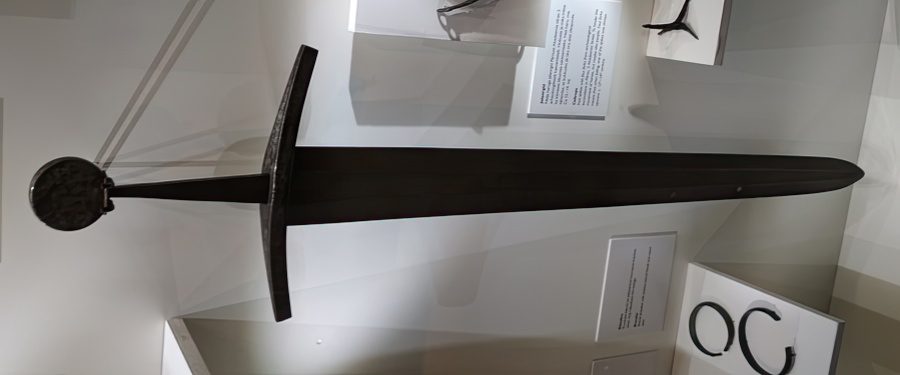
The Viking invasions in this era heavily influenced the design of English swords, though it is important to note that there was significant overlap with the Anglo-Saxon design. Some hilts now featured a curved crossguard with a more elaborate pommel. The Viking sword blades often sported a wide fuller, or groove, down the center which helped balance the sword and made it easier to wield.
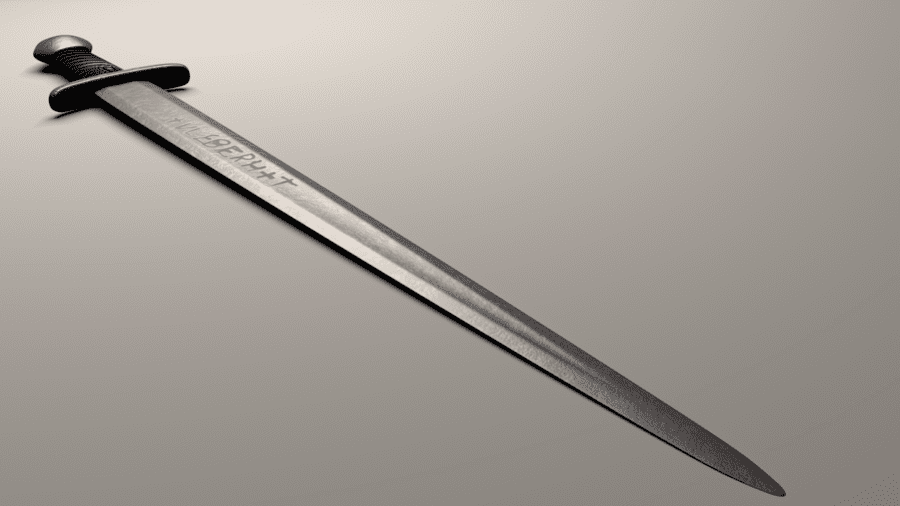
By this time, metallurgy had improved to make solid steel which improved the quality and strength of the weapon. Among the highest quality Viking swords are the Ulfberht swords that were stronger, sharper, and more flexible than any other swords in Northern Europe at the time. The Ulfberht swords are considered the pinnacle of Viking sword technology because of their homogeneous steel composition, and these swords were massively influential to the evolution of Northern European swords in the Middle Ages.
3. The Arming Sword (11th-14th Century AD)
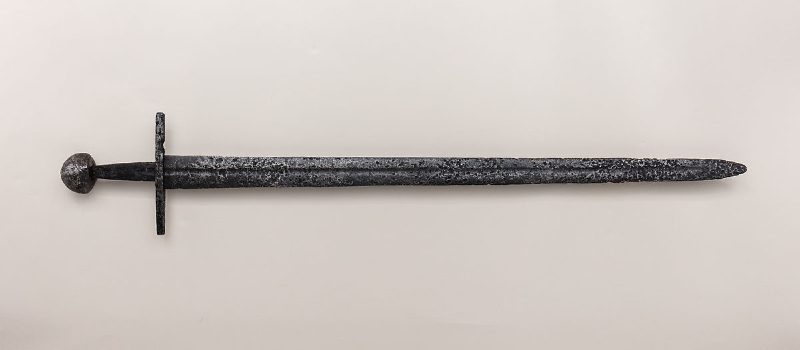
In the aftermath of the Norman conquest in the mid-11th century, the arming sword rose to prominence in England. With a double-edged blade of about 30 inches in length and a cruciform hilt, this single-handed short sword was ideal for slashing and thrusting while using a shield. The blades of this period became more slender and balanced, improving wieldability by moving the center of mass closer to the hilt.
This medieval sword became the standard issue weapon of knights as indicated by its nickname, the “knightly sword.” Knights carried this sword even when out of uniform, and during the Holy Wars from the 11th-13th centuries, the crusaders carried these swords with them to Jerusalem.
After our next sword became the most popular weapon of choice in the late middle ages, the arming sword continued to be carried as a side arm, which is how it earned its name.
4. The Longsword (14th-15th Century AD)
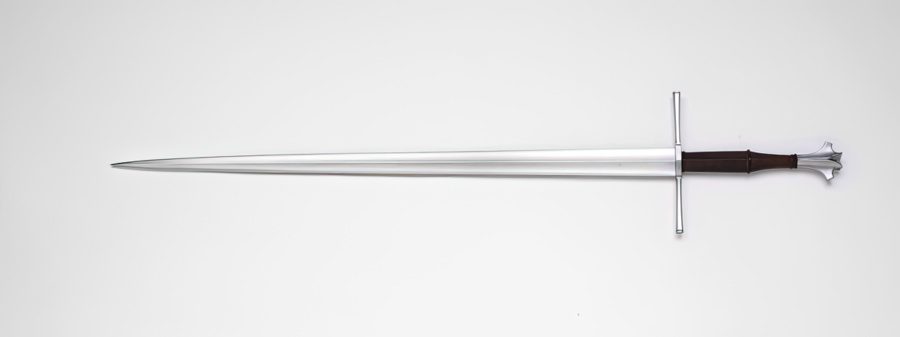
One of the most popular and effective swords of all time, the longsword represents hundreds of years of technological innovation and design. By lengthening the hilt to allow for a two-handed grip, the longsword was also called the “hand-and-a-half sword,” and it allowed its wielder to generate more power with each stroke and thrust.
By this time, most soldiers in major battles were outfitted in full plate armor, allowing them to navigate the battlefield without a shield, freeing up an extra hand. Variations in the design of the longsword abound, but distinct features include the elongated hilt of about 10-15 inches, a straight double edged blade between 35-45 inches, a straight crossguard that provides protection to the hand, and a larger rounded pommel that acts as a counterweight and can be used offensively in close combat to bash opponents’ helms.
The blade also featured a fuller to balance the weight, and it typically tapered to a sharp point, making it ideal for thrusting at enemies from further distances. The longsword was extremely versatile in battle, and though it was designed to be used with two hands, it could also be wielded one-handed. This in-between one- and two-hand status earned the longsword the nickname “the bastard sword.”
On many longswords, the bottom of the blade was blunted, allowing for users to grab it and more effectively stab in close quarters. Perhaps the most famous battle in English history featuring longsword combat was the Battle of Barnet during the Wars of the Roses. Though cannons had been developed by this time, due to a heavy fog created by gunsmoke and early morning mist, artillery had been rendered useless. For over three hours, soldiers from both sides engaged in brutal hand-to-hand sword combat, and in this battle, the longsword was essential for its versatility.
5. The Greatsword (14th-16th Century AD)
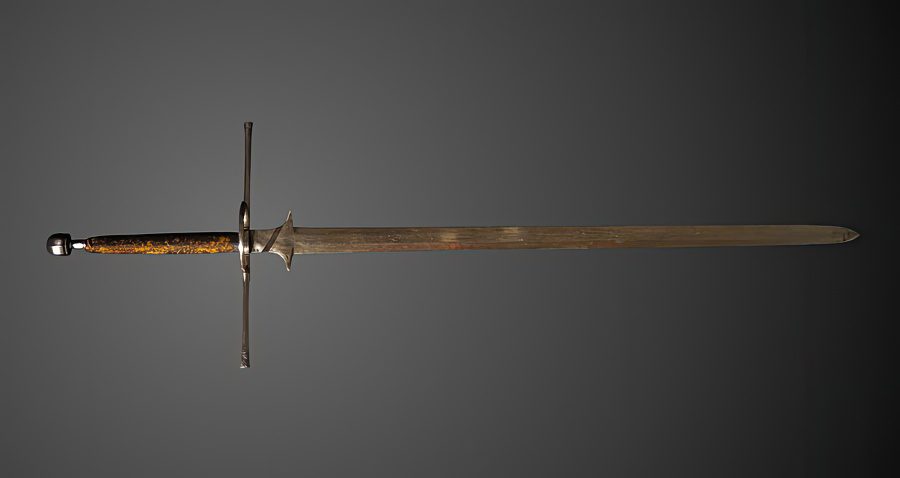
Also known as the English two-hand sword, the greatsword donned a mammoth 50-70 inch blade perfect for smashing plate armor. With an extended two-handed hilt, the greatsword also featured a ricasso, an unsharpened bottom of the blade that allowed soldiers to control the sword more effectively.
Because of its bulk and difficulty to maneuver, the Greatsword was used only by certain infantry soldiers for specialized purposes, such as breaking through the enemies’ front lines with smashing blows from a distance during the later stages of the Hundred Years’ War and the Wars of the Roses. Though not the most versatile weapon, the greatsword was effective at dazing and concussing opponents when a blow was landed, perfect for the smashing kind of combat seen during the 14th and 15th century wars of England.
6. The Rapier (16th-17th Century AD)
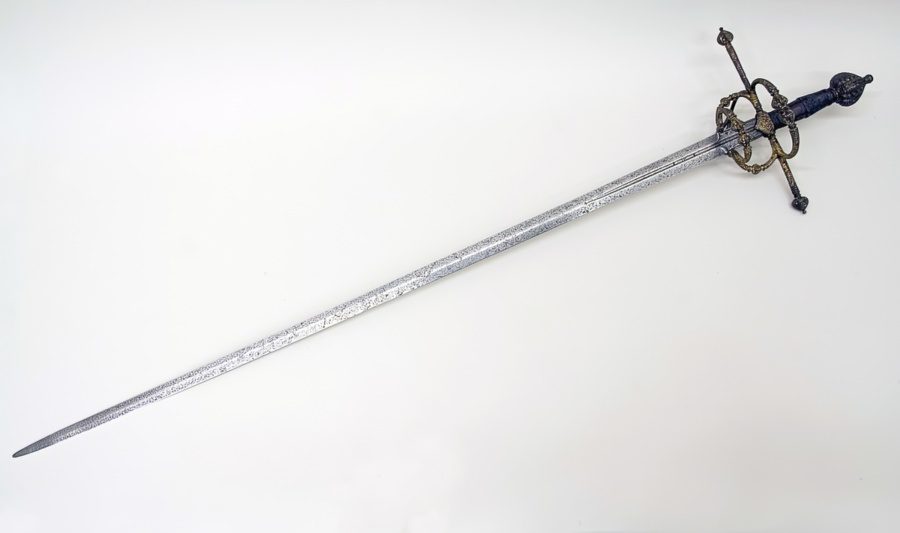
During the Renaissance, the slender, single-handed rapier was invented for civilian self-defense, dueling, and fencing. Originally developed in Spain, the rapier quickly spread to the rest of Europe, including England, where its design was altered to fit the fashion of Britain.
Flashing a blade between 30-45 inches, this weapon was designed for thrusting attacks. The rapier was popular among noble gentlemen of the era who sported it as a sidearm accessory, and, because of this, the design of the pommel and crossguard were typically much more ornate than battlefield weapons.
It is in this period that the practices of dueling and fencing became more popular, and for these purposes, the rapier was the perfect sword. Though not being of much practical use on the battlefield, the rapier signals a transition in sword history away from primary battlefield weapon to more civilian and ceremonious purposes as gunpowder technology became more and more effective.
7. The Basket-hilted sword (17th-18th Century AD)
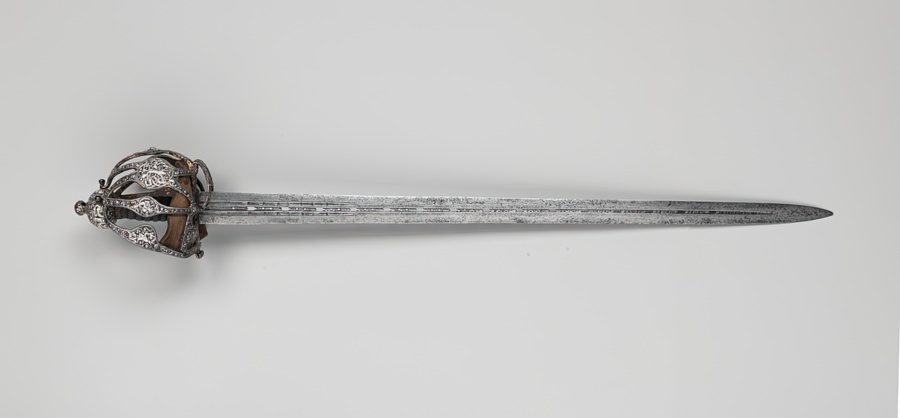
A broadsword whose design was influenced by the rapier, the basket-hilted sword gets its name from the distinctive hilt that encloses the wielder’s hand, offering more protection and a better grip. The double-edged blade was around 30-38 inches and ideal for both cutting and thrusting.
In England, the basket-hilted sword was adopted by both infantry and cavalry and featured prominently during the 17th century English Civil War. Regional variations of the sword abounded, and in Scotland, the basket-hilted claymore (different from the claymore greatsword that preceded it) was an extremely popular weapon among the Northerners. The English backsword was a single-edge variant of the basket-hilted sword that also enjoyed widespread use.
8. The Cutlass (17th-19th Century)

Short, broad, and slightly curved, the cutlass was adopted by the British Royal Navy as a standard sidearm in the late 18th century. The cutlass was perfect for slashing and chopping, and its effectiveness in close quarter combat made it the perfect weapon for fighting on ships.
The blade of a cutlass averaged between 24-30 inches and was usually reinforced at the spine, offering a stronger and sturdier design perfect for cutting anything from the ropes of a ship to a pirate’s neck. The hilt typically offered hand protection in the form of a knuckle guard or a more elaborate cup shape.
The cutlass was phased out as an official sidearm of the Royal Navy in the late 19th century, but its status as the sword of the sea will forever be etched into the iconography of pirates and sailors of this era.
9. The Cavalry Sabre (17th-19th Century AD)
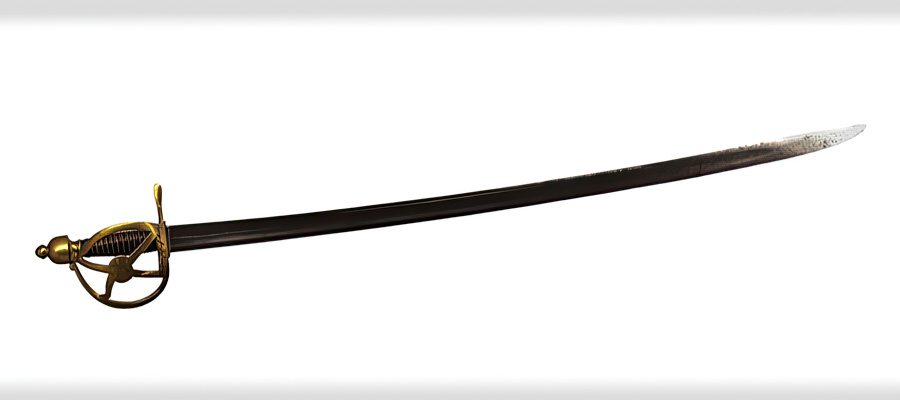
Adopted by the English Cavalry in the late 18th century, the cavalry sabre became an incredibly important weapon through the Napoleonic Wars and beyond. The curved, single-edge blade was perfect for high-speed cutting and slashing atop horseback, and the design of the English sabre was heavily influenced by Austro-Hungarian swords of the time.
In 1796, famous sword designer and fencing instructor John Gaspard le Marchant collaborated with Birmingham-based swordsmith Henry Osborn to create a new Light Cavalry Sabre. As light cavalry units charged their opponents, this extremely curved sword tore through enemy lines and was a very important weapon for the English in their wars against Napoleon.
In addition to the Light Cavalry Sword, a Heavy Cavalry straight, double-edged sword was employed for Heavy Dragoons, but it was not nearly as effective in battle as the Light Cavalry cutter. The Cavalry Sabre underwent further changes after the Napoleonic Wars and remained the standard issue for cavalry units until the late 19th century, when swords took on a much more symbolic role as the gun conquered the battlefield.
10. The Infantry Officer’s Sword (17th Century AD – Present)
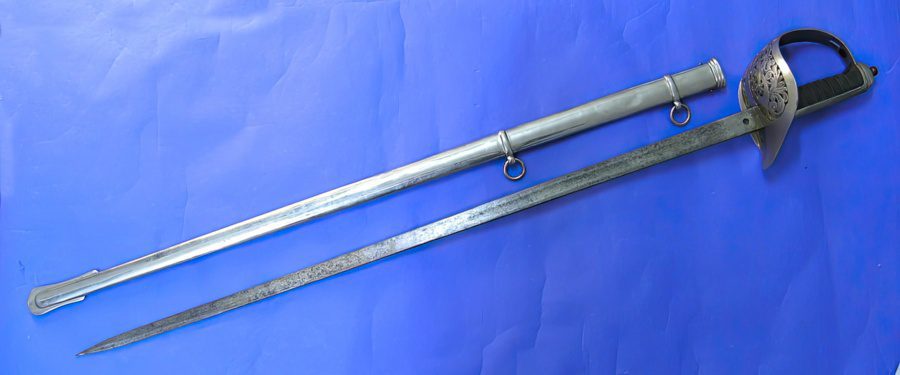
The Infantry Officer’s sword has been a symbol of military rank since the 17th century, and though the sword has transitioned from a functional weapon to more of a symbolic token, the infantry officer’s sword still commands respect and prestige within the military. When the infantry officer’s sword was first introduced, it resembled the arming swords of the day, with a straight, double-edged blade ideal for cutting and thrusting.
In 1796, a new officer’s sword was introduced amid the Napoleonic Wars, one that featured a single-edge, slightly curved blade. This new design promoted swift maneuverability and was influenced by the cavalry sabres of the time. Between 1822 and 1845, a new pattern introduced a gothic gilt-brass hilt with a hinged guard.
In 1897, the present-day iteration of the officer’s sword was issued, featuring a three-quarter basket guard attached to a straight, blunted blade that only sharpens towards the top third to support thrusting attacks.
There is more: Arms and Armor
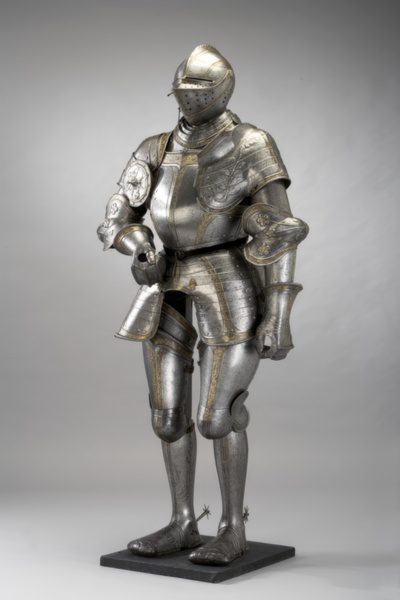
An important trend to remember when discussing the evolution of swords is the intrinsic relationship between arms and armor. When one changes, the other must respond. In the Middle Ages, armor technology advanced rapidly, going from iron plates to chain-mail to full plate armor.
Slashing an Anglo-Saxon or Viking sword against full-plate armor was essentially useless, and thus, we see evolutions in sword technology. Thrusting became much more important because it was easier to target weaknesses in the armor with a more measured attack.
Early in the Middle Ages, the use of a shield in battle was imperative, so swords had to be wieldable with one hand. As full-plate armor developed, the need for a shield dissipated, and swords became bigger and longer because two hands were available. Because full plate armor was almost entirely impenetrable to the slashing of a blade, smashing an opponent over the head or trying to crush the armor was an important technique in order to daze or weaken the enemy. This also influenced the development of other weapons like the mace.
Wars and the way they were fought changed dramatically from the Middle Ages into the Renaissance and Enlightenment, and sword design responded to these changes. It is important to keep in mind that each sword served a specific purpose and was responding to the historical context around it.
